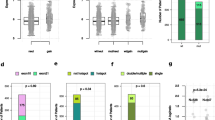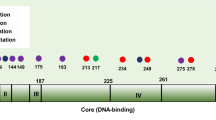Abstract
The 11q13 region is amplified in approximately 15% of all breast tumors. Situated in this region are the cyclin D1 gene (CCND1) and the p-21-activated kinase 1 (PAK1) gene. Both genes encode proteins shown to activate the estrogen receptor (ER), leading to transcription of CCND1 and other ER-responsive genes. Here, we investigate the prognostic and treatment predictive role of CCND1 and PAK1 gene amplification in postmenopausal breast cancer patients randomized to tamoxifen treatment or no adjuvant treatment. Amplification of CCND1 and PAK1, assessed by real-time PCR, was observed in 12.5 and 9.3%, respectively. Amplification of PAK1 was seen in 37% of the CCND1-amplified tumors, indicating coamplification (P<0.001). In ER-positive patients, amplification of at least one of the genes indicated a reduced recurrence-free survival (P=0.025). When response to tamoxifen treatment was analysed, patients with PAK1 amplification showed decreased benefit from the drug (ER+; relative risk ratio (RR)=1.62; 95% confidence interval (CI), 0.47–5.55) compared to patients without amplification (ER+; RR=0.53; 95% CI, 0.32–0.88). This was not evident for CCND1 amplification. We show that PAK1 may be a predictor of tamoxifen resistance and furthermore, we do not discard PAK1 as a potential candidate oncogene in the 11q13 amplicon. In addition, we show that high pak1 protein levels may predict tamoxifen insensitivity.
This is a preview of subscription content, access via your institution
Access options
Subscribe to this journal
Receive 50 print issues and online access
$259.00 per year
only $5.18 per issue
Buy this article
- Purchase on Springer Link
- Instant access to full article PDF
Prices may be subject to local taxes which are calculated during checkout




Similar content being viewed by others
References
Ahnström M, Nordenskjöld B, Rutqvist LE, Skoog L, Stål O . (2005). Role of cyclin D1 in ErbB2-positive breast cancer and tamoxifen resistance. Breast Cancer Res Treat 91: 145–151.
Albertson DG . (2006). Gene amplification in cancer. Trends Genet 22: 447–455.
Ali S, Coombes RC . (2002). Endocrine-responsive breast cancer and strategies for combating resistance. Nat Rev Cancer 2: 101–112.
Al-Kuraya K, Schraml P, Torhorst J, Tapia C, Zaharieva B, Novotny H et al. (2004). Prognostic relevance of gene amplifications and coamplifications in breast cancer. Cancer Res 64: 8534–8540.
Askmalm MS, Carstensen J, Nordenskjöld B, Olsson B, Rutqvist LE, Skoog L et al. (2004). Mutation and accumulation of p53 related to results of adjuvant therapy of postmenopausal breast cancer patients. Acta Oncol 43: 235–244.
Balasenthil S, Barnes CJ, Rayala SK, Kumar R . (2004a). Estrogen receptor activation at serine 305 is sufficient to upregulate cyclin D1 in breast cancer cells. FEBS Lett 567: 243–247.
Balasenthil S, Sahin AA, Barnes CJ, Wang RA, Pestell RG, Vadlamudi RK et al. (2004b). p21-activated kinase-1 signaling mediates cyclin D1 expression in mammary epithelial and cancer cells. J Biol Chem 279: 1422–1428.
Bekri S, Adelaide J, Merscher S, Grosgeorge J, Caroli-Bosc F, Perucca-Lostanlen D et al. (1997). Detailed map of a region commonly amplified at 11q13 → q14 in human breast carcinoma. Cytogenet Cell Genet 79: 125–131.
Bernards R . (1999). CDK-independent activities of D type cyclins. Biochim Biophys Acta 1424: M17–M22.
Bièche I, Olivi M, Nogues C, Vidaud M, Lidereau R . (2002). Prognostic value of CCND1 gene status in sporadic breast tumours, as determined by real-time quantitative PCR assays. Br J Cancer 86: 580–586.
Brown LA, Irving J, Parker R, Kim H, Press JZ, Longacre TA et al. (2006). Amplification of EMSY, a novel oncogene on 11q13, in high grade ovarian surface epithelial carcinomas. Gynecol Oncol 100: 264–270.
Champeme MH, Bièche I, Lizard S, Lidereau R . (1995). 11q13 amplification in local recurrence of human primary breast cancer. Genes Chromosomes Cancer 12: 128–133.
Cuny M, Kramar A, Courjal F, Johannsdottir V, Iacopetta B, Fontaine H et al. (2000). Relating genotype and phenotype in breast cancer: an analysis of the prognostic significance of amplification at eight different genes or loci and of p53 mutations. Cancer Res 60: 1077–1083.
Doisneau-Sixou SF, Sergio CM, Carroll JS, Hui R, Musgrove EA, Sutherland RL . (2003). Estrogen and antiestrogen regulation of cell cycle progression in breast cancer cells. Endocr Relat Cancer 10: 179–186.
Fantl V, Richards MA, Smith R, Lammie GA, Johnstone G, Allen D et al. (1990). Gene amplification on chromosome band 11q13 and oestrogen receptor status in breast cancer. Eur J Cancer 26: 423–429.
Fu M, Wang C, Li Z, Sakamaki T, Pestell RG . (2004). Minireview: Cyclin D1: normal and abnormal functions. Endocrinology 145: 5439–5447.
Hodges LC, Cook JD, Lobenhofer EK, Li L, Bennett L, Bushel PR et al. (2003). Tamoxifen functions as a molecular agonist inducing cell cycle-associated genes in breast cancer cells. Mol Cancer Res 1: 300–311.
Holm C, Rayala S, Jirström K, Stål O, Kumar R, Landberg G . (2006). Association between Pak1 expression and subcellular localization and tamoxifen resistance in breast cancer patients. J Natl Cancer Inst 98: 671–680.
Jin S, Zhuo Y, Guo W, Field J . (2005). p21-activated Kinase 1 (Pak1)-dependent phosphorylation of Raf-1 regulates its mitochondrial localization, phosphorylation of BAD, and Bcl-2 association. J Biol Chem 280: 24698–24705.
Jirström K, Stendahl M, Ryden L, Kronblad A, Bendahl PO, Stål O et al. (2005). Adverse effect of adjuvant tamoxifen in premenopausal breast cancer with cyclin D1 gene amplification. Cancer Res 65: 8009–8016.
Jordan VC . (2006). Pak up your breast tumor – and grow!. J Natl Cancer Inst 98: 657–659.
Karlseder J, Zeillinger R, Schneeberger C, Czerwenka K, Speiser P, Kubista E et al. (1994). Patterns of DNA amplification at band q13 of chromosome 11 in human breast cancer. Genes Chromosomes Cancer 9: 42–48.
Kyomoto R, Kumazawa H, Toda Y, Sakaida N, Okamura A, Iwanaga M et al. (1997). Cyclin-D1-gene amplification is a more potent prognostic factor than its protein over-expression in human head-and-neck squamous-cell carcinoma. Int J Cancer 74: 576–581.
Li F, Adam L, Vadlamudi RK, Zhou H, Sen S, Chernoff J et al. (2002). p21-activated kinase 1 interacts with and phosphorylates histone H3 in breast cancer cells. EMBO Rep 3: 767–773.
Mayr D, Kanitz V, Anderegg B, Luthardt B, Engel J, Lohrs U et al. (2006). Analysis of gene amplification and prognostic markers in ovarian cancer using comparative genomic hybridization for microarrays and immunohistochemical analysis for tissue microarrays. Am J Clin Pathol 126: 101–109.
Menard RE, Jovanovski AP, Mattingly RR . (2005). Active p21-activated kinase 1 rescues MCF10A breast epithelial cells from undergoing anoikis. Neoplasia 7: 638–645.
Miyamoto R, Uzawa N, Nagaoka S, Hirata Y, Amagasa T . (2003). Prognostic significance of cyclin D1 amplification and overexpression in oral squamous cell carcinomas. Oral Oncol 39: 610–618.
Neuman E, Ladha MH, Lin N, Upton TM, Miller SJ, DiRenzo J et al. (1997). Cyclin D1 stimulation of estrogen receptor transcriptional activity independent of cdk4. Mol Cell Biol 17: 5338–5347.
Ormandy CJ, Musgrove EA, Hui R, Daly RJ, Sutherland RL . (2003). Cyclin D1, EMS1 and 11q13 amplification in breast cancer. Breast Cancer Res Treat 78: 323–335.
Rayala SK, Molli PR, Kumar R . (2006a). Nuclear p21-activated kinase 1 in breast cancer packs off tamoxifen sensitivity. Cancer Res 66: 5985–5988.
Rayala SK, Talukder AH, Balasenthil S, Tharakan R, Barnes CJ, Wang RA et al. (2006b). P21-activated kinase 1 regulation of estrogen receptor-alpha activation involves serine 305 activation linked with serine 118 phosphorylation. Cancer Res 66: 1694–1701.
Rennstam K, Baldetorp B, Kytola S, Tanner M, Isola J . (2001). Chromosomal rearrangements and oncogene amplification precede aneuploidization in the genetic evolution of breast cancer. Cancer Res 61: 1214–1219.
Rutqvist LE, Johansson H . (2006). Long-term follow-up of the Stockholm randomized trials of postoperative radiation therapy versus adjuvant chemotherapy among ‘high risk’ pre- and postmenopausal breast cancer patients. Acta Oncol 45: 517–527.
Schraml P, Schwerdtfeger G, Burkhalter F, Raggi A, Schmidt D, Ruffalo T et al. (2003). Combined array comparative genomic hybridization and tissue microarray analysis suggest PAK1 at 11q13.5-q14 as a critical oncogene target in ovarian carcinoma. Am J Pathol 163: 985–992.
Schuuring E . (1995). The involvement of the chromosome 11q13 region in human malignancies: cyclin D1 and EMS1 are two new candidate oncogenes – a review. Gene 159: 83–96.
Singh RR, Song C, Yang Z, Kumar R . (2005). Nuclear localization and chromatin targets of p21-activated kinase 1. J Biol Chem 280: 18130–18137.
Vadlamudi RK, Adam L, Wang RA, Mandal M, Nguyen D, Sahin A et al. (2000). Regulatable expression of p21-activated kinase-1 promotes anchorage-independent growth and abnormal organization of mitotic spindles in human epithelial breast cancer cells. J Biol Chem 275: 36238–36244.
Vadlamudi RK, Barnes CJ, Rayala S, Li F, Balasenthil S, Marcus S et al. (2005). p21-activated kinase 1 regulates microtubule dynamics by phosphorylating tubulin cofactor B. Mol Cell Biol 25: 3726–3736.
Wang RA, Mazumdar A, Vadlamudi RK, Kumar R . (2002). P21-activated kinase-1 phosphorylates and transactivates estrogen receptor-alpha and promotes hyperplasia in mammary epithelium. EMBO J 21: 5437–5447.
Wang RA, Zhang H, Balasenthil S, Medina D, Kumar R . (2006). PAK1 hyperactivation is sufficient for mammary gland tumor formation. Oncogene 25: 2931–2936.
Wong LJ, Dai P, Lu JF, Lou MA, Clarke R, Nazarov V . (2006). AIB1 gene amplification and the instability of polyQ encoding sequence in breast cancer cell lines. BMC Cancer 6: 111.
Zwijsen RM, Buckle RS, Hijmans EM, Loomans CJ, Bernards R . (1998). Ligand-independent recruitment of steroid receptor coactivators to estrogen receptor by cyclin D1. Genes Dev 12: 3488–3498.
Zwijsen RM, Wientjens E, Klompmaker R, van der Sman J, Bernards R, Michalides RJ . (1997). CDK-independent activation of estrogen receptor by cyclin D1. Cell 88: 405–415.
Acknowledgements
This study was supported by grants from the Swedish Cancer Society.
Author information
Authors and Affiliations
Corresponding author
Rights and permissions
About this article
Cite this article
Bostner, J., Ahnström Waltersson, M., Fornander, T. et al. Amplification of CCND1 and PAK1 as predictors of recurrence and tamoxifen resistance in postmenopausal breast cancer. Oncogene 26, 6997–7005 (2007). https://doi.org/10.1038/sj.onc.1210506
Received:
Revised:
Accepted:
Published:
Issue Date:
DOI: https://doi.org/10.1038/sj.onc.1210506
Keywords
This article is cited by
-
Comprehensive analysis of the prognostic implications and functional exploration of PAK gene family in human cancer
Cancer Cell International (2022)
-
Invasive lobular carcinoma with extracellular mucin (ILCEM): clinicopathologic and molecular characterization of a rare entity
Modern Pathology (2022)
-
CCND1 Amplification in Breast Cancer -associations With Proliferation, Histopathological Grade, Molecular Subtype and Prognosis
Journal of Mammary Gland Biology and Neoplasia (2022)
-
CCND1 and FGFR1 gene amplifications are associated with reduced benefit from aromatase inhibitors in metastatic breast cancer
Clinical and Translational Oncology (2021)
-
Mitotic count can predict tamoxifen benefit in postmenopausal breast cancer patients while Ki67 score cannot
BMC Cancer (2018)



